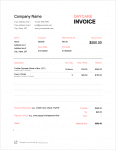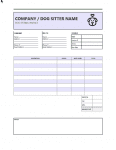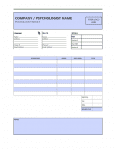Hourly Invoice Template
An hourly invoice is a document used to charge for the number of hours dedicated to providing a service. While similar to a bill, the invoice differs in that it typically does not need to be paid immediately, but within the number of days listed on the document. There are two ways to charge for a service, one being hourly (this version), the other being a pre-determined amount.
Types (3)
 Daycare – Given to the parents or guardians of a child to collect payment for rendered childcare services. Can also be used for charging for any food (or other products) provided to the child during their care.
Daycare – Given to the parents or guardians of a child to collect payment for rendered childcare services. Can also be used for charging for any food (or other products) provided to the child during their care.
 Dog Sitting – Bills customers for dog sitting care provided by a professional. Standard services include dog walking, feeding, and playtime.
Dog Sitting – Bills customers for dog sitting care provided by a professional. Standard services include dog walking, feeding, and playtime.
 Psychologist – Provided post-session to clients to inform them of the time (hours), hourly rate, and total amount due for mental-health services they received.
Psychologist – Provided post-session to clients to inform them of the time (hours), hourly rate, and total amount due for mental-health services they received.
Pros & Cons of Charging Hourly
The Pros of charging by the hour include:
- Considerably Less Risk – When working with a fixed rate, if a client requests revisions on work performed, or requests an additional service within the scope of the project, the value of the overall project is diluted – as the same amount is paid regardless of the amount of work. With hourly pricing, revisions or additions to the project only mean the company or freelancer is working more for less.
- More Straightforward – A flat rate allows customers to take a look at a company’s rate and compare it with others in their field. There’s no guesswork, and it allows less work on the company’s end when going after potential clients.
The Cons of charging an hourly rate:
- It can Sway a Client’s Decision – Say a mechanic is being asked to replace the Catalytic Converter on a client’s Tahoe. When the client asked for a quote, the mechanic can either tell them a) it will cost $150 to replace or b) “it’ll take 30min to an hour to replace, and I charge $150/hr.” The client will obviously like the sound of option a (assuming they are not familiar with automotive work), as in their mind, the job could have taken 3 hours to complete, only costing them $50/hr.
- Charging Hourly Limits Potential – There are only so many hours in a day. By charging a standard rate for work, company’s and contractors can only make a certain amount of money in a day – regardless of how much gets done. By charging upfront for a project, the only limiting factor is the amount of work that can be completed. Over time, workers develop methods and processes that increase the speed at which work is completed, in turn, leaving clients impressed by the drive and efficiency of the hired service.
How to Write
Step 1 – Download
Download the invoice in PDF or WORD format.
Step 2 – Company Details
Enter the Company Name and Contact Information in the fields at the top of the page.
Step 3 – The Client
Fill in the contact information of the client being billed for your services, which includes the Invoice Number, Date (that the invoice was issued), Phone Number, Full Name, and Address.
Step 4 – The Services
Next, enter a short summary of the service(s) that were completed in the Description column. Followed by the number of Hours that each job took to complete, the Hourly Rate ($ / Hour), and the total Amount per service.
Step 5
Below the table, enter the Total Labor, which is found by adding up the values in the Amount column. Add on any Sales Tax to find the TOTAL invoice amount. In the fields to the left of the totals, write any Notes specific to the jobs completed and any info on accepted payment methods, followed by the number of Days the customer has to pay the full invoice amount.
